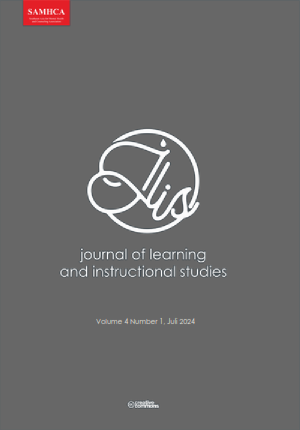Main Article Content
Abstract
The purpose of this research is to know the effect of using Audio-Lingual method towards student’s listening skills of SMPN 5 South Tambun. This research is a quantitative form using experimental and control methods. The sample of this research is 40 students with 20 students in the experimental class and 20 students in the control class. The result of mean for the experiment class shows 77,5, the median is 80,12, the modus is 84,5, the standard deviation is 13,80 and the variance is 190,526. In other hand, the result of mean for the control class shows 61, the median 59,5, the modus 55,5, the standard deviation is 13,86 and the variance is 192,368. The result of research show Tcount = 4,67 at a significant level α = 0,05, Tscore = 1,68, thus it can be concluded that Tcount > Tscore that is 4,67 > 1,68. These result indicate that the null hypothesis (Ho) is rejected and the research hypothesis (H1) is accepted. Therefore, the writet realizes that there is an Effect of Using Audio-Lingual Method on The Student’s Listening Skill at The First Grade Student of SMPN 5 South Tambun.
Article Details

This work is licensed under a Creative Commons Attribution 4.0 International License.
References
- Arifin, Z. (2020). Higher Education Research Methodology. Metodologi Penelitian Pendidikan. https://doi.org/10.4324/9781315149783
- Maesaroh, S. (2013). Peranan Metode Pembelajaran Terhadap Minat Dan Prestasi Belajar Pendidikan Agama Islam. Jurnal Kependidikan, 1(1), 150–168. https://doi.org/10.24090/jk.v1i1.536
- Mulyadi, D., & Mutmainnah, Y. (2015). Penggunaan Film Berbahasa Inggris dengan English Subtitle dalam Meningkatkan Keterampilan Listening. The 2nd University Research Coloquium 2015, 141. https://media.neliti.com/media/publications/176452-ID-penggunaan-film-berbahasa-inggris-dengan.pdf
- Netriwati. (2017). Buku Metode Pembelajaran.
- Purwanto, N. (2019). Variabel Dalam Penelitian Pendidikan. Jurnal Teknodik, 6115, 196–215. https://doi.org/10.32550/teknodik.v0i0.554
- Sardiyanah. (2019). Pendekatan Dan Metode Audio Lingual (Analisis Metode Sam’iyah Safawiyah). NASKHI :Jurnal Kajian Pendidikan Dan Bahasa Arab, Vol. 1(No.1), Hlm. 14-20. http://journal.iaimsinjai.ac.id/index.php/naskhi/article/view/67/21
- Satria, T. G. (2017). Meningkatkan Keterampilan Menyimak Melalui Pendekatan Saintifik Pada Anak Kelas Iv Jakarta Barat. Jurnal PGSD, 10(2), 114–120. https://doi.org/10.33369/pgsd.10.2.114-120
- Sudrajat, A. (2008). Pengertian Pendekatanx. Academia, 1–5. https://www.academia.edu/16448048/Pengertian_Pendekatanx
- Suseno, I., Marjoko, & U.S, S. (2013). pengantar Statistik Untuk Penelitian Pendidikan. UNINDRA PRESS.
- Triyadi, S. (2015). Efektivitas Penggunaan Media Audio-Visual Untuk Meningkatkan Keterampilan Menyimak Siswa Pada Mata Pelajaran Pendidikan Bahasa Indonesia. Jurnal Pendidikan Unsika, 3(2), 188–199. https://journal.unsika.ac.id/index.php/judika/article/view/215
- Yumna, G. (2023). Pengaruh Penggunaan Metode Audio-Lingual Terhadap Keterampilan Berbicara Peserta didik Berbantuan Media Audio Visual di Kelas V SDN 1 Pajaresuk. Skripsi.
References
Arifin, Z. (2020). Higher Education Research Methodology. Metodologi Penelitian Pendidikan. https://doi.org/10.4324/9781315149783
Maesaroh, S. (2013). Peranan Metode Pembelajaran Terhadap Minat Dan Prestasi Belajar Pendidikan Agama Islam. Jurnal Kependidikan, 1(1), 150–168. https://doi.org/10.24090/jk.v1i1.536
Mulyadi, D., & Mutmainnah, Y. (2015). Penggunaan Film Berbahasa Inggris dengan English Subtitle dalam Meningkatkan Keterampilan Listening. The 2nd University Research Coloquium 2015, 141. https://media.neliti.com/media/publications/176452-ID-penggunaan-film-berbahasa-inggris-dengan.pdf
Netriwati. (2017). Buku Metode Pembelajaran.
Purwanto, N. (2019). Variabel Dalam Penelitian Pendidikan. Jurnal Teknodik, 6115, 196–215. https://doi.org/10.32550/teknodik.v0i0.554
Sardiyanah. (2019). Pendekatan Dan Metode Audio Lingual (Analisis Metode Sam’iyah Safawiyah). NASKHI :Jurnal Kajian Pendidikan Dan Bahasa Arab, Vol. 1(No.1), Hlm. 14-20. http://journal.iaimsinjai.ac.id/index.php/naskhi/article/view/67/21
Satria, T. G. (2017). Meningkatkan Keterampilan Menyimak Melalui Pendekatan Saintifik Pada Anak Kelas Iv Jakarta Barat. Jurnal PGSD, 10(2), 114–120. https://doi.org/10.33369/pgsd.10.2.114-120
Sudrajat, A. (2008). Pengertian Pendekatanx. Academia, 1–5. https://www.academia.edu/16448048/Pengertian_Pendekatanx
Suseno, I., Marjoko, & U.S, S. (2013). pengantar Statistik Untuk Penelitian Pendidikan. UNINDRA PRESS.
Triyadi, S. (2015). Efektivitas Penggunaan Media Audio-Visual Untuk Meningkatkan Keterampilan Menyimak Siswa Pada Mata Pelajaran Pendidikan Bahasa Indonesia. Jurnal Pendidikan Unsika, 3(2), 188–199. https://journal.unsika.ac.id/index.php/judika/article/view/215
Yumna, G. (2023). Pengaruh Penggunaan Metode Audio-Lingual Terhadap Keterampilan Berbicara Peserta didik Berbantuan Media Audio Visual di Kelas V SDN 1 Pajaresuk. Skripsi.

